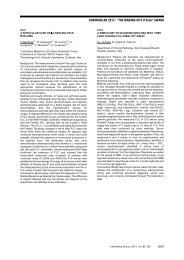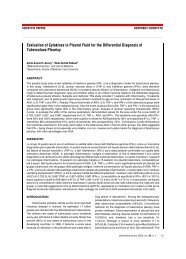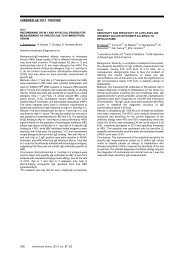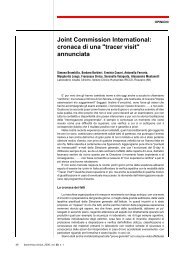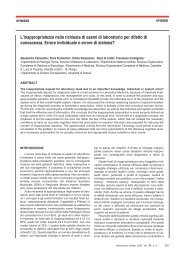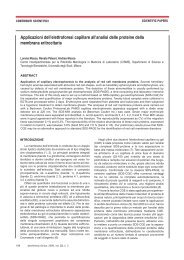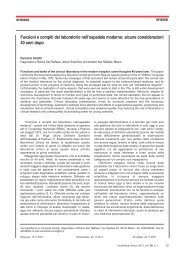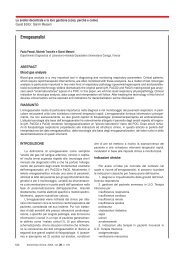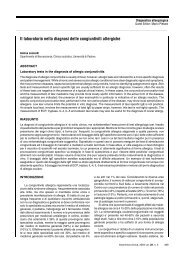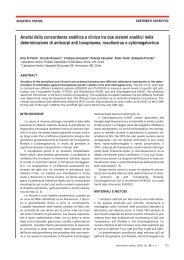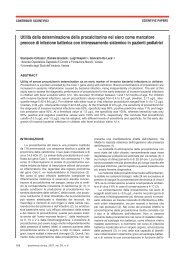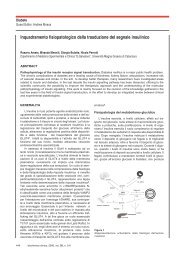Field evaluation of the GeneXpert system for detection of ... - SIBioC
Field evaluation of the GeneXpert system for detection of ... - SIBioC
Field evaluation of the GeneXpert system for detection of ... - SIBioC
Create successful ePaper yourself
Turn your PDF publications into a flip-book with our unique Google optimized e-Paper software.
SCIENTIFIC PAPERS CONTRIBUTI SCIENTIFICI<br />
DISCUSSION<br />
FVL mutation is <strong>the</strong> most important genetic risk factor<br />
<strong>for</strong> venous thromboembolism and <strong>the</strong> mutation in <strong>the</strong> 3’untranslated<br />
region <strong>of</strong> <strong>the</strong> prothrombin gene seems to be<br />
ano<strong>the</strong>r mild risk factor <strong>for</strong> thrombotic events. It has been<br />
clearly shown that FVL is frequently co-inherited with <strong>the</strong><br />
GPro variant (18). The association <strong>of</strong> <strong>the</strong> two<br />
prothrombotic alleles indicate that <strong>the</strong> prothrombin<br />
variant is an additional risk factor <strong>for</strong> venous<br />
thromboembolism and might contribute to thrombotic<br />
manifestations (19).<br />
Chioggia is a town <strong>of</strong> about 60,000 inhabitants, built<br />
in a group <strong>of</strong> islands in <strong>the</strong> sou<strong>the</strong>rn part <strong>of</strong> <strong>the</strong> Venice<br />
lagoon; <strong>for</strong> logistic reason, <strong>the</strong>re is actually only a street<br />
connecting Chioggia with <strong>the</strong> mainland and, until <strong>the</strong> end<br />
<strong>of</strong> XIX century, <strong>the</strong> town remained quite secluded from<br />
<strong>the</strong> surrounding areas. So that, as previously reported,<br />
we observed a high prevalence <strong>of</strong> FVL in patients<br />
studied to detect thrombophilia risk factors after<br />
thrombosis, even in <strong>the</strong> open population (20-23).<br />
There<strong>for</strong>e, a rapid, simple and relatively cheap test <strong>for</strong><br />
<strong>the</strong> simultaneous <strong>detection</strong> <strong>of</strong> <strong>the</strong> point mutations <strong>for</strong><br />
FVL and GPro was considered <strong>of</strong> great utility in our<br />
laboratory practice. Various different methods <strong>for</strong> <strong>the</strong><br />
simultaneous <strong>detection</strong> were described in literature. All<br />
<strong>the</strong>se methods required DNA extraction followed by<br />
amplification reaction and, <strong>of</strong>ten, fur<strong>the</strong>r analysis <strong>of</strong> <strong>the</strong><br />
amplification products, e.g., enzyme digestion (9, 10, 24,<br />
25).<br />
We reported here our field experience by using a fast<br />
and simple test <strong>for</strong> simultaneous <strong>detection</strong> <strong>of</strong> FVL and<br />
GPro. In our <strong>evaluation</strong>, <strong>GeneXpert</strong> assay <strong>for</strong> combined<br />
<strong>detection</strong> <strong>of</strong> FVL and GPro showed a full concordance<br />
with Roche Light Cycler assay. Ano<strong>the</strong>r advantage <strong>of</strong> <strong>the</strong><br />
simultaneous FVL and GPro assay was <strong>the</strong> reduction in<br />
costs and labour by 50%, because patients with a<br />
mutated allele <strong>for</strong> factor V and/or prothrombin variant are<br />
identified in a single step.<br />
The <strong>GeneXpert</strong> <strong>system</strong> represents an important new<br />
development in <strong>the</strong> field <strong>of</strong> molecular diagnostics. It<br />
automates all steps <strong>of</strong> nucleic acid amplification in a<br />
disposable, micr<strong>of</strong>luidic cartridge. It is a moderately<br />
complex test, but is simple enough to be reliably<br />
per<strong>for</strong>med by individuals without a specific background<br />
in nucleic acid diagnostics. Samples and buffers are <strong>the</strong><br />
only components to be added to <strong>the</strong> cartridge by <strong>the</strong><br />
user. The device has independently controlled and<br />
operated analysis modules that facilitate testing <strong>of</strong><br />
individual samples in a random-access mode. The test<br />
incorporates an internal control, which ensures that <strong>the</strong><br />
entire test <strong>system</strong> is functioning properly, and a probe<br />
check control step, per<strong>for</strong>med be<strong>for</strong>e PCR, to verify<br />
reagent rehydration, probe integrity, and PCR tube filling<br />
in <strong>the</strong> cartridge. So, by using <strong>the</strong> <strong>GeneXpert</strong> HemosIL<br />
Factor II and Factor V assay, it is possible to per<strong>for</strong>m<br />
genetic tests in complete automation from <strong>the</strong> addition <strong>of</strong><br />
whole blood and reagents to <strong>the</strong> cartridge to final results,<br />
without <strong>the</strong> need <strong>of</strong> fur<strong>the</strong>r analytical phase, e.g., DNA<br />
extraction, or <strong>the</strong> need <strong>of</strong> special location <strong>for</strong> molecular<br />
biology assays. The assay <strong>for</strong>mat was studied to<br />
minimize waste and to permit single test execution. The<br />
<strong>system</strong> is uniquely suited <strong>for</strong> clinical applications <strong>of</strong><br />
molecular diagnostics when on-demand testing and<br />
rapid-result capability are needed.<br />
REFERENCES<br />
1. De Stefano V, Rossi E, Paciaroni K, et al. Screening <strong>for</strong><br />
inherited thrombophilia: indications and <strong>the</strong>rapeutic<br />
implications. Haematologica 2002;87:1095-108.<br />
2. Tripodi A, Mannucci P. Laboratory investigation <strong>of</strong><br />
thrombophilia. Clin Chem 2001;47:1597-606.<br />
3. Somma J, Sussman I, Rand J. An <strong>evaluation</strong> <strong>of</strong><br />
thrombophilia screening in an urban tertiary care medical<br />
center: a “real word” experience. Am J Clin Pathol<br />
2006;126:1-8.<br />
4. Sayinalp N, Haznedaroğlu I, Aksu S, et al. The<br />
predictability <strong>of</strong> factor V Leiden (FV:Q506) gene mutation<br />
via clotting based diagnosis <strong>of</strong> activated protein C<br />
resistance. Clin Appl Thromb Hemost 2004;10;265-70.<br />
5. Irdem A, Devecioglu C, Batun S, et al. Prevalence <strong>of</strong> factor<br />
V Leiden and prothrombin G20210A gene mutation. Saudi<br />
Med J 2005;26:580-3.<br />
6. Zoller B, Garcia de Frutos P, Dahlback B. Thrombophilia as<br />
a multigenic disease. Haematologica 1999;84:59-70.<br />
7. Heit J. The epidemiology <strong>of</strong> venous thromboembolism in<br />
<strong>the</strong> community: implications <strong>for</strong> prevention and<br />
management. J Thromb Thrombolysis 2006;21:23-9.<br />
8. Pajič T. Factor V Leiden and FII 20210 testing in<br />
thromboembolic disorders. Clin Chem Lab Med<br />
2010;48(suppl 1):S79-87.<br />
9. Cooper P, Cooper S, Smith J, et al. Evaluation <strong>of</strong> <strong>the</strong><br />
Roche Light Cycler: a simple and rapid method <strong>for</strong> direct<br />
<strong>detection</strong> <strong>of</strong> factor V Leiden and prothrombin 20210<br />
genotypes from blood samples without <strong>the</strong> need <strong>for</strong> DNA<br />
extraction. Blood Coag Fibrinolysis 2003;15:499-503.<br />
10. Nauck M, Marz W, Wieland H. Evaluation <strong>of</strong> <strong>the</strong> Roche<br />
diagnostic Light Cycler factor V Leiden mutation <strong>detection</strong><br />
kit and <strong>the</strong> Light Cycler prothrombin mutation <strong>detection</strong> kit.<br />
Clin Biochem 2000;33:213-6.<br />
11. Moure R, Muñoz L, Torres M, et al. Rapid <strong>detection</strong> <strong>of</strong><br />
Mycobacterium tuberculosis complex and rifampin<br />
resistance in smear-negative clinical samples by use <strong>of</strong> an<br />
integrated real-time PCR method. J Clin Microbiol<br />
2011;49:1137-9.<br />
12. Morelli B, Novelli C, Grassi C, et al. An automation<br />
experience in molecular biology: <strong>the</strong> GeneXper Dx<br />
System <strong>for</strong> FV Leiden and FH 20210A mutation <strong>detection</strong>.<br />
Haematologica 2008;93(suppl 3):76.<br />
13. Kost C, Rogers B, Oberste M, et al. Multicentric beta trial<br />
<strong>of</strong> <strong>the</strong> <strong>GeneXpert</strong> enterovirus assay. J Clin Microbiol<br />
2007;45:1081-6.<br />
14. Raja S, Ching J, Xi L, et al. Technology <strong>for</strong> automated<br />
rapid and quantitative PCR or reverse transcription PCR<br />
clinical testing. Clin Chem 2005;51:882-90.<br />
15. Mamotte C. Genotyping <strong>of</strong> single nucleotide substitutions.<br />
Clin Biochem Rev 2006;27:63-75.<br />
16. Carters R, Ferguson J, Gaut R, et al. Design and use <strong>of</strong><br />
scorpions fluorescent signaling molecules. Methods Mol<br />
Biol 2008;429:99-115.<br />
17. Reynisson E, Josefsen MH, Krause M, et al. Evaluation <strong>of</strong><br />
probe chemistries and plat<strong>for</strong>ms to improve <strong>the</strong> <strong>detection</strong><br />
limit <strong>of</strong> real-time PCR. J Microbiol Methods 2006;66:206-16.<br />
18. Franchini M, Veneri D, Salvagno G, et al. Inherited<br />
thrombophilia. Crit Rev Clin Lab Sci 2006;43:249-50.<br />
biochimica clinica, 2012, vol. 36, n. 1 23



